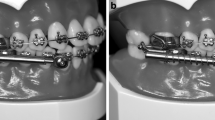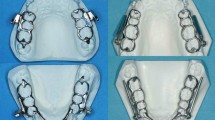Abstract
Objective
The aim of this study was to evaluate the therapeutic effects of the Sabbagh Universal Spring 2 (SUS 2) fixed functional appliance compared to the premolar extraction method in correcting class II/1 malocclusion in patients who had passed their peak of postpubertal growth (stages 4–6 of Cervical Vertebral Maturation Index).
Methods
In all, 40 class II/1 patients were randomized to receive SUS 2 application (7 males, 13 females, age 15.75 ± 1.02 years) or maxillary premolar extraction (8 males, 12 females, age 15.40 ± 0.99 years). Pre- and posttreatment digital cephalographs were traced at least twice. A paired t test was used to compare the pre- and posttreatment measurements. Treatment changes were compared using an independent samples t test (P ≤ 0.05).
Results
The extent of change was significant in the following variables: ANB, nasolabial angle, Mand1-ML, 1L-NB, anterior and posterior facial heights, N-A-Pog, 1U-NF, 6L-MP, Ar-Go, OP-HP, A-B, A-Sn, B-Sm, APDI, NAPog, AB-NPog, POr-DOP, SN-OcP, POr-OcP, Wits, 1 l-APog, 1LMeLm, S-Go:N-Me, N-ANS-Pog, Ap1LAp1u-DOP, ANS-Cond, Pog-Cond, SS-Ls, A-N-Pog, Pog–Pog′, MeGoOcP, 1L-Npog, Go-Me, Go-Me:N-S, S-Me, Ls-(Sn-Pog′), Stms–Stmi, N′-Gn′, N′NsPog′, 6u-PTV, 1u-NA, FMIA, and IMPA.
Conclusions
SUS 2 corrected class II/1 malocclusion of patients in the postpubertal growth period by inhibiting the maxilla’s forward growth, advancing the mandible, decreasing the nasolabial and interincisal angles, proclining the incisors, increasing the facial height, and clockwise rotation of the occlusal plane. Extraction reduced the interincisal angle and protruded the lower incisors. However, it did not change the soft tissue thickness and did not cause a clockwise rotation in the occlusal plane.
Zusammenfassung
Ziel
Evaluiert werden sollten die Effekte einer Behandlung mit der SUS 2 (Sabbagh Universal Spring 2)-Feder im Vergleich mit denen einer Prämolarenextraktion im Oberkiefer zur Korrektur einer Klasse-II/1-Malokklusion bei Patienten nach dem pubertären Wachstumsschub [CVMI („cervical maturation index“)-Stadien 4–6].
Methoden
Insgesamt 40 Klasse-II/1-Patienten wurden randomisiert in 2 Gruppen eingeteilt: eine mit SUS 2-Behandlung (7 männliche, 13 weibliche, 15,75 ± 1,02 Jahre), die andere mit Prämolarenextraktion im Oberkiefer (8 männliche, 12 weibliche, 15,40 ± 0,99 Jahre). Vor und nach Behandlung erstellte digitale Kephalogramme wurden mindestens zweimal ausgewertet. Zum Vergleich prä- und posttherapeutischer Messungen diente der gepaarte t-Test, zum Vergleich der Veränderungen nach Behandlung der t-Test für unabhängige Stichproben (p ≤ 0,05).
Ergebnisse
Bei den im Folgenden aufgeführten Variablen war das Ausmaß der Veränderungen signifikant: ANB, Nasolabialwinkel, Mand1-ML, 1L-NB, anteriore und posteriore Gesichtshöhe, N-A-Pog, 1U-NF, 6L-MP, Ar-Go, OP-HP, A-B, A-Sn, B-Sm, APDI, NAPog, AB-NPog, POr-DOP, SN-OcP, POr-OcP, Wits, 1 l-APog, 1LMeLm, S-Go:N-Me, N-ANS-Pog, Ap1LAp1u-DOP, ANS-Cond, Pog-Cond, SS-Ls, A-N-Pog, Pog–Pog′, MeGoOcP, 1L-Npog, Go-Me, Go-Me:N-S, S-Me, Ls-(Sn-Pog′), Stms–Stmi, N′-Gn′, N′NsPog′, 6u-PTV, 1u-NA, FMIA und IMPA.
Schlussfolgerungen
Die SUS 2-Feder korrigierte eine Klasse-II/1-Malokklusion bei Patienten nach der pubertären Hauptwachstumsphase durch Hemmung des Oberkieferwachstums nach anterior, Vorverlagerung der Mandibula, Verringerung der nasolabialen und interinzisiven Winkel, Proklination der Schneidezähne, gesteigerte Gesichtshöhe und Rotation der Okklusalebene nach rechts. Eine Prämolarenextraktion dagegen verringerte den interinzisiven Winkel und führte zu einer Protrusion der Unterkieferschneidezähne. Die Weichteildicke dagegen veränderte sich nicht und es zeigte sich keine Rotation nach rechts in der Okklusalebene.
Similar content being viewed by others
References
Aelbers CF, Dermaut L (1996) Orthopedics in orthodontics: part I, fiction or reality—a review of the literature. Am J Orthod Dentofac Orthop 110:513–519
Booij JW, Goeke J, Bronkhorst EM et al (2013) Class II treatment by extraction of maxillary first molars or Herbst appliance: dentoskeletal and soft tissue effects in comparison. J Orthop 74:52–63
Cassidy DW, Herbosa EG, Rotskoff KS et al (1993) A comparison of surgery and orthodontics in “borderline” adults with Class II, division 1 malocclusions. Am J Orthod Dentofac Orthop 104:455–470
Chen JY, Will LA, Niederman R (2002) Analysis of efficacy of functional appliances on mandibular growth. Am J Orthod Dentofac Orthop 122:470–476
Covell DA Jr, Trammell DW, Boero RP et al (1999) A cephalometric study of class II division 1 malocclusions treated with the Jasper Jumper appliance. Angle Orthod 69:311–320
Dermaut LR, Aelbers CM (1996) Orthopedics in orthodontics: fiction or reality. A review of the literature—part II. Am J Orthod Dentofac Orthop 110:667–671
Hanandeh BA, El-Bialy AA (2010) Evaluating the effect of Sabbagh Universal Spring during treatment of growing class II malocclusions. Int J Orthod Milwaukee 21:13–24
Herrera-Sanches FS, Henriques JF, Janson G et al (2013) Class II malocclusion treatment using Jasper Jumper appliance associated to intermaxillary elastics: a case report. Dental Press J Orthod 18:22–29
Karacay S, Akin E, Olmez H et al (2006) Forsus Nitinol Flat Spring and Jasper Jumper corrections of class II division 1 malocclusions. Angle Orthod 76:666–672
Khosravanifard B, Rakhshan V, Raeesi E (2013) Factors influencing attractiveness of soft tissue profile. Oral Surg Oral Med Oral Pathol Oral Radiol 115:29–37
Kinzinger G, Diedrich P (2005) Skeletal effects in class II treatment with the functional mandibular advancer (FMA). J Orofac Orthop 66:469–490
Kinzinger G, Frye L, Diedrich P (2009) Class II treatment in adults: comparing camouflage orthodontics, dentofacial orthopedics and orthognathic surgery—a Cephalometric Study to evaluate various therapeutic effects. J Orofac Orthop 70:63–91
Kucukkeles N, Ilhan I, Orgun IA (2007) Treatment efficiency in skeletal class II patients treated with the jasper jumper. Angle Orthod 77:449–456
Kucukkeles N, Orgun A (1995) Correction of Class II malocclusions with a Jasper Jumper in growing patients. Eur J Orthod 17:445
Lange DW, Kalra V, Broadbent BH Jr et al (1995) Changes in soft tissue profile following treatment with the bionator. Angle Orthod 65:423–430
McNamara JA, Howe RP, Dischinger TG (1990) A comparison of the Herbst and Fränkel appliances in the treatment of Class II malocclusion. Am J Orthod Dentofac Orthop 98:134–144
Mihalik CA, Proffit WR, Phillips C (2003) Long-term follow-up of Class II adults treated with orthodontic camouflage: a comparison with orthognathic surgery outcomes. Am J Orthod Dentofac Orthop 123:266–278
Nalbantgil D, Arun T, Sayinsu K et al (2005) Skeletal, dental and soft-tissue changes induced by the Jasper Jumper appliance in late adolescence. Angle Orthod 75:426–436
Nanda R (2015) Current therapy in orthodontics. Mosby Elsevier, London
Ngan PW, Byczek E, Scheick J (1997) Longitudinal evaluation of growth changes in class II division 1 subjects. Semin Orthod 3:222–231
Oztoprak MO, Nalbantgil D, Uyanlar A et al (2012) A cephalometric comparative study of class II correction with Sabbagh Universal Spring (SUS(2)) and Forsus FRD appliances. Eur J Dent 6:302–310
Pancherz H (1982) The mechanism of Class II correction in Herbst appliance treatment. A cephalometric investigation. Am J Orthod 82:104–113
Pancherz H (1985) The Herbst appliance—its biologic effects and clinical use. Am J Orthod 87:1–20
Pancherz H (1997) The effects, limitations, and long-termdentofacial adaptations to treatment with the herbst appliance. In: Seminars in Orthodontics, vol 4. Elsevier, pp 232–243
Pancherz H, Fackel U (1990) The skeletofacial growth pattern pre- and post-dentofacial orthopaedics. A long-term study of Class II malocclusions treated with the Herbst appliance. Eur J Orthod 12:209–218
Proffit WR, Phillips C, Douvartzidis N (1992) A comparison of outcomes of orthodontic and surgical-orthodontic treatment of class II malocclusion in adults. Am J Orthod Dentofac Orthop 101:556–565
Rakhshan V, Rakhshan H, Sheibaninia A (2009) Developing an automatic lateral cephalometric landmark identification program and evaluating its performance. Int J Comput Dent 12:327–343
Ruf S, Pancherz H (1999) Dentoskeletal effects and facial profile changes in young adults treated with the Herbst appliance. Angle Orthod 69:239–246
Ruf S, Pancherz H (2004) Orthognathic surgery and dentofacial orthopedics in adult Class II Division 1 treatment: mandibular sagittal split osteotomy versus Herbst appliance. Am J Orthod Dentofac Orthop 126:140–152
Valant JR, Sinclair PM (1989) Treatment effects of the Herbst appliance. Am J Orthod Dentofac Orthop 95:138–147
Weiland FJ, Bantleon HP (1995) Treatment of Class II malocclusions with the Jasper Jumper appliance—a preliminary report. Am J Orthod Dentofac Orthop 108:341–350
Weiland FJ, Droschl H (1996) Treatment of a Class II, Division 1 malocclusion with the Jasper Jumper: a case report. Am J Orthod Dentofac Orthop 109:1–7
Yang X, Zhu Y, Long H et al (2016) The effectiveness of the Herbst appliance for patients with Class II malocclusion: a meta-analysis. Eur J Orthod 38:324–333
Authors’ contributions
Siamak Hemmatpour searched the literature, performed the orthodontic treatments, re-traced a number of cephalographs, and mentored the thesis. Ali Mokhtar searched the literature, conceived and designed the study, traced all cephalographs, collected the data, wrote the thesis, and contributed to justification of findings in the paper. Vahid Rakhshan searched the literature, double-checked data consistency, performed thesis analyses, conceived extra analyses for the article (more variables, comparison of before-after data in each method), prepared the figures with written permission from OnyxCeph, and drafted/revised/submitted the article.
Author information
Authors and Affiliations
Corresponding author
Ethics declarations
Funding
The study was self-funded by the authors and their institution.
Conflict of interest
S. Hemmatpour, A. Mokhtar, and V. Rakhshan declare that they have no competing interest.
All procedures performed in studies involving human participants were in accordance with the ethical standards of the institutional and/or national research committee and with the 1964 Helsinki declaration and its later amendments or comparable ethical standards. Informed consent was obtained from all individual participants included in the study.
Additional information
Assistant Professor: Siamak Hemmatpour; Former Resident: Ali Mokhtar; Lecturer: Vahid Rakhshan.
Electronic supplementary material
Below is the link to the electronic supplementary material.



Figure 3. Important landmarks, measurements, and terminologies used in the Burstone Profile analysis











Rights and permissions
About this article
Cite this article
Hemmatpour, S., Mokhtar, A. & Rakhshan, V. Effects of Sabbagh Universal Spring 2 fixed functional appliance on class II/1 patients at their postpubertal-peak growth period compared with the extraction method. J Orofac Orthop 78, 41–51 (2017). https://doi.org/10.1007/s00056-016-0060-2
Received:
Accepted:
Published:
Issue Date:
DOI: https://doi.org/10.1007/s00056-016-0060-2
Keywords
- Class II division 1
- Fixed functional appliances
- Sabbagh Universal Spring 2
- Maxillary premolar extraction
- Cervical Vertebral Maturation Index




